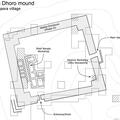Fish Resources in an Early Urban Context at Harappa
Fishing is often neglected in studies of urban societies. This is unfortunate as the study of fish can reveal aspects of subsistence, regional trade, access to resources, and social organization. Coastal and inland relationships can be examined by considering marine and riverine species variation.









